Are you ready to start your fitness journey but hate crowded gyms or expensive memberships? Look no further than your living room. The best home workout routine for beginners is here to help you begin your fitness journey easily.
Key Takeaways:
- Discover a comprehensive beginner-friendly workout you can do at home with no equipment.
- Learn the benefits of home workouts, including time and cost savings, privacy, and flexibility.
- Understand the essential equipment and warm-up techniques to maximize your home training experience.
- Explore fundamental bodyweight exercises and how to build core strength at home.
- Uncover strategies for progressive overload, recovery, and creating a sustainable workout schedule.
Understanding the Benefits of Home Workouts
For those looking to live healthier, at-home training is a big plus. It means no need to go to the gym. This makes it easy for beginner fitness folks to work out in their own space. It’s a great choice for those new to exercise.
Time and Cost Efficiency
Home workout videos save a lot of time and money. You don’t have to travel to the gym. This means more time for working out and less money spent on gym memberships. It’s a smart way for beginners to start their fitness journey.
Privacy and Comfort Advantages
Working out at home is private and comfortable. It’s perfect for beginner fitness people. You don’t have to worry about what others think. This helps you feel more confident and comfortable as you start your fitness journey.
Flexibility in Schedule
Home workouts fit your schedule. You can work out when it’s best for you. This makes it easier to stick to your exercise plan over time.
Home workouts are a great way for beginner fitness people to start their fitness journey. They offer convenience, privacy, and flexibility. This makes it easier to stay on track with your fitness goals.
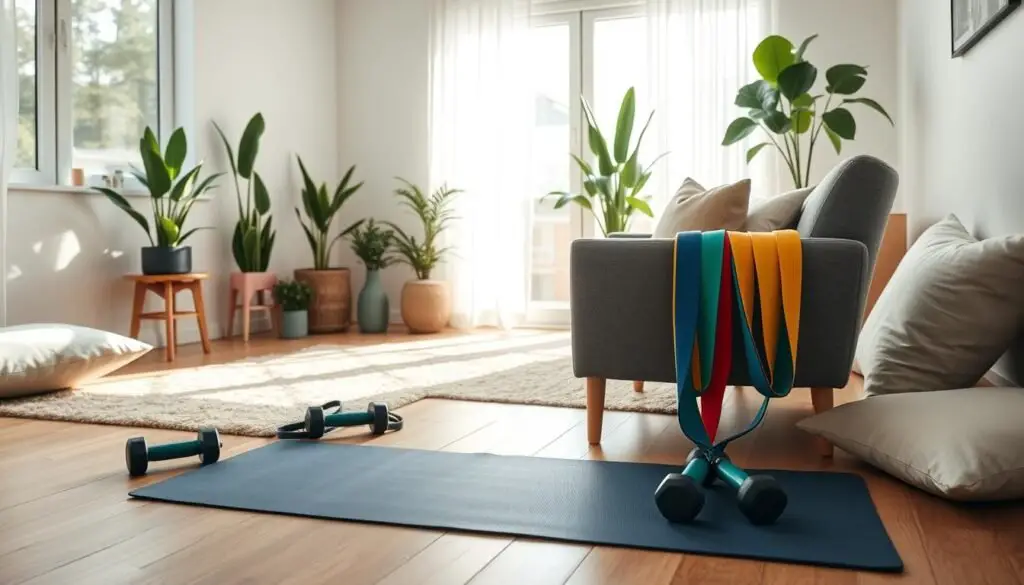
Essential Equipment for Home Training
You don’t need a lot of expensive gear to work out at home. Simple, affordable tools and your body can help you get a great workout. You can do it all from your living room.
Start with bodyweight exercises like push-ups, squats, and planks. They need no extra equipment and work your whole body. As you get better, add dumbbells or resistance bands for more challenge.
Get a yoga mat for comfort and support. It’s great for floor exercises and adds cushioning. A chair is also useful for assisted squats and other exercises.
Begin with the basics of bodyweight exercises before adding more gear. This helps you learn proper form and technique. Remember, your body is the most important tool. With a bit of creativity, you can get great results without a gym.
| Equipment | Price Range | Key Features |
|---|---|---|
| CAP Barbell 150-Pound Dumbbell Set | Around $370 | Cast iron material, includes 5- to 25-pound dumbbells, 30-day warranty |
| Rogue T-15 lb Technique Bar | Around $165 | Aluminum and zinc material, weighs 15 pounds, made in the USA |
| Fringe Sport Black Bumper Plates | $80 to $270 | Rubber and stainless steel material, warranty of 3 years (25-55 pounds) and 1 year (10-15 pounds), 50.4 mm insert diameter |
| Gritin Resistance Bands | Around $10 | Rubber material, includes 5 bands per set with a resistance range of 5-40 pounds |
| Sole F63 Treadmill | Around $1,100 | Features Bluetooth speakers, USB port, device holder, 15 levels of incline, cushioned deck, 20″ W x 60″ L belt, weight capacity of 325 pounds, lifetime frame and motor warranty |
Also, think about getting a Future Online Personal Trainer and a Fitbit Inspire 2 Fitness Tracker. They can guide your no equipment workouts and track your progress. With the right tools and some creativity, you can create a great bodyweight exercises routine at home.

Proper Warm-Up Techniques for Home Exercise
Starting your home workout journey? Make sure to warm up right. A good warm-up boosts your workout and keeps you safe from injuries. It gets your heart rate up and blood flowing to your muscles, readying you for tough at-home training.
Dynamic Stretching Routines
Forget static stretches and go for dynamic ones. Try arm swings, side reaches, and knee lifts. Also, do lateral lunges, plié squats, and squats with reach. These moves get your muscles ready and improve flexibility for a safe home workout.
Joint Mobility Exercises
Don’t overlook joint mobility in your warm-up. Do arm circles and hip rotations to loosen up your joints. This gets you ready for your beginner fitness routine and helps prevent injuries.
Light Cardio Activities
Get your heart rate up with light cardio like jumping jacks or high knees for 2-3 minutes. This boosts blood flow and warms you up for your home workout videos. These simple steps make you feel confident and safe.
“Proper warm-ups increase muscle and joint flexibility, enhancing exercise form and minimizing injury risk.”
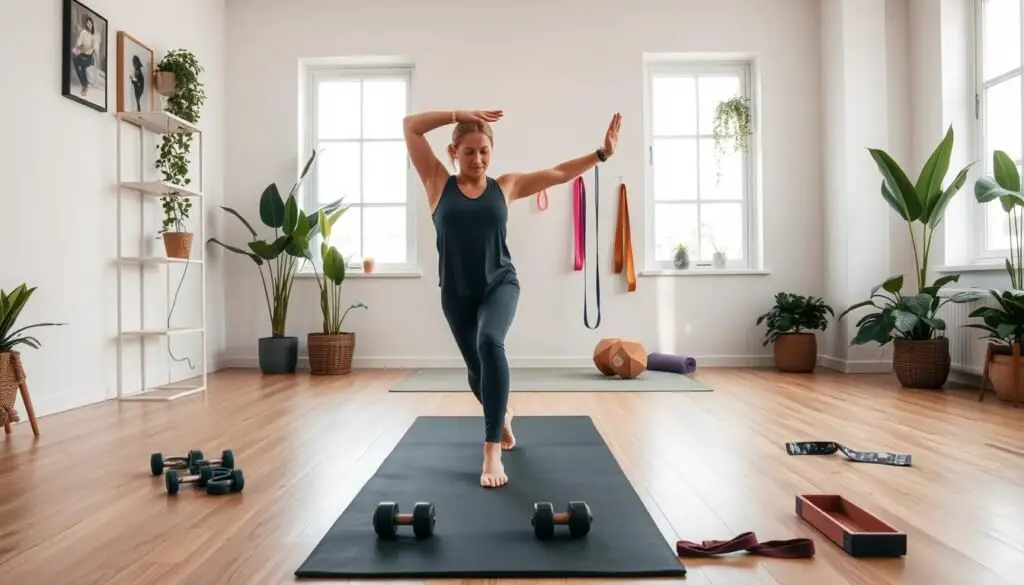
Best Home Workout Routine for Beginners
Starting a fitness journey can feel overwhelming, especially for newbies. But, the right home workout routine can help you build strength and improve your heart health. You can reach your wellness goals without expensive gym memberships or special gear. This beginner-friendly plan uses bodyweight exercises and strength training to kickstart your fitness journey.
For an effective home workout, start simple and focus on doing each exercise right. Begin with wall push-ups, assisted bodyweight squats, knee push-ups, stationary lunges, and planks. Do 2 sets of 10-15 reps for each, resting for 30-60 seconds between moves. This routine should take about 15-20 minutes to finish.
As you get better, increase the number of reps or try harder versions of exercises. Add exercises like bridges, chair squats, and bicycle crunches to work your whole body. This will help you build a strong base for more advanced workouts.
The key to a lasting home workout routine for beginners is to be consistent, focus on form, and progress slowly. With dedication and patience, you’ll reach your fitness goals from home.
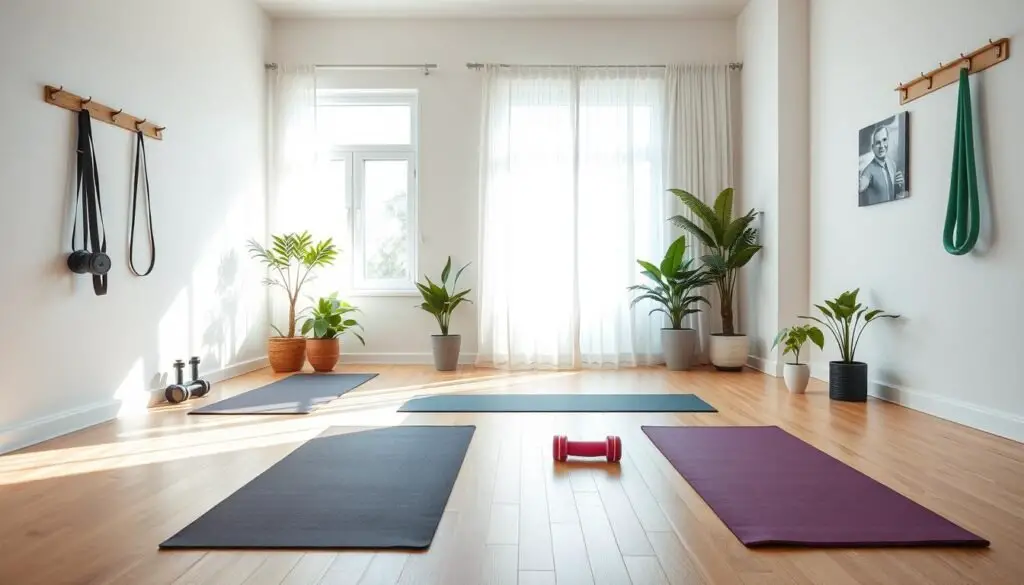
“Consistency is key when it comes to any fitness routine, especially for beginners. Start small, focus on proper form, and celebrate your progress along the way.”
Fundamental Bodyweight Exercises
Starting your strength training journey with bodyweight exercises is a great choice. These exercises are easy to do without any equipment. They help beginners build a strong base and gain confidence for harder workouts.
Push-up Variations
The push-up is a key exercise with many variations. Beginners can start with wall push-ups, lowering their chest towards a wall. As they get stronger, they can try incline push-ups and knee push-ups. Finally, they can do the standard push-up with hands shoulder-width apart.
Squat Techniques
Squats are essential for working the legs and core. Beginners can use a chair or wall for support. Once they’re ready, they can do a bodyweight squat, bending their hips and knees until their thighs are almost parallel to the ground.
Plank Positions
Planks are great for strengthening the core and back. Beginners can start with a forearm plank, holding a straight line from head to heels. They can then move to a high plank with arms extended. Side planks are also a good option for targeting the obliques.
Remember, proper form is key when doing these exercises. Start slow and gradually increase the challenge as you get stronger. With consistent practice and patience, you’ll master these exercises and build a strong body.
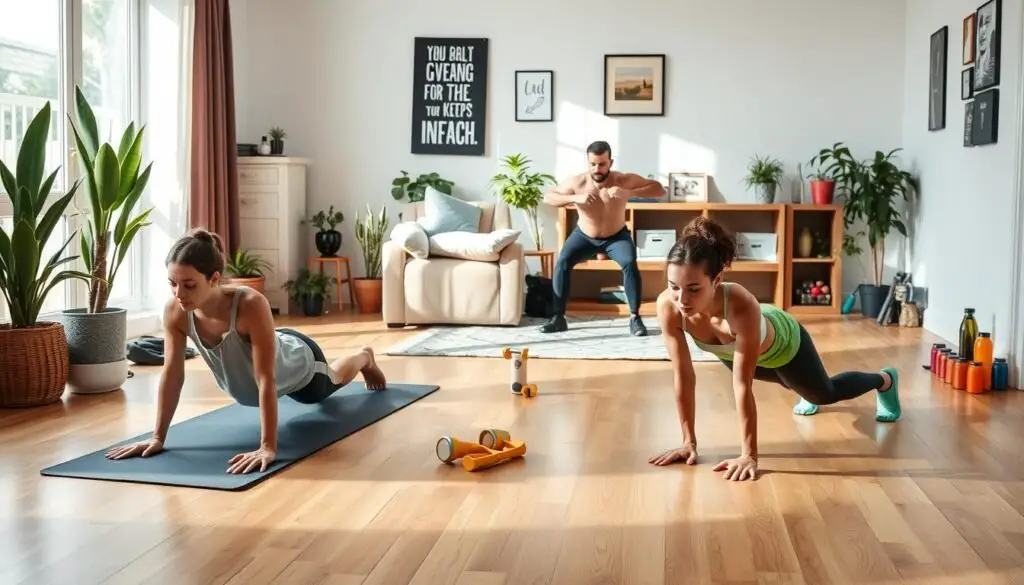
Building Core Strength at Home
Having a strong core is key for at-home training and staying fit. You can work on your core strength at home with just a few exercises. Lindsey Clayton, a senior instructor at Barry’s in New York City, says side planks and bear planks are vital for runners. They should be part of any strength training for beginners.
The best core workout includes exercises for pelvic stability, balance, and obliques. Try Alternating Bird Dog, Bear Plank Hold, and Supported Side Plank with Hip Dip. Also, do Dead Bug, Alternating Leg Lift, and Bicycle Crunch. Each exercise targets your core differently, boosting your bodyweight exercises strength and stability.
To do this core workout, do each exercise for 50 seconds, then rest for 10 seconds. Aim for 1-2 rounds for the best results. Make sure to engage your core in each exercise to feel the burn and get the most benefits.
| Exercise | Description | Benefits |
|---|---|---|
| Alternating Bird Dog | Start on all fours, then extend one arm and the opposite leg, alternating sides. | Improves balance and stability, targets the core and back muscles. |
| Bear Plank Hold | Hold a high plank position with your knees bent and feet lifted off the floor. | Engages the entire core, including the abs, obliques, and lower back. |
| Supported Side Plank with Hip Dip | Perform a side plank, dipping your hips towards the floor and then returning to the starting position. | Strengthens the obliques and challenges core stability. |
| Dead Bug | Lie on your back with your arms extended overhead and legs raised. Slowly lower one arm and the opposite leg, then switch sides. | Targets the transverse abdominis, a deep core muscle, and improves overall core control. |
| Alternating Leg Lift | Lie on your back with your arms at your sides. Lift one leg at a time, keeping the other leg straight and close to the ground. | Strengthens the rectus abdominis and hip flexors. |
| Bicycle Crunch | Lie on your back, bringing your knees in toward your chest and alternating elbow to knee. | Engages the obliques and the rectus abdominis. |
Adding these core-strengthening at-home training exercises to your strength training for beginners routine will help you build a strong core. This will support your fitness goals and bodyweight exercises. Always focus on proper form and engaging your core for the best results.
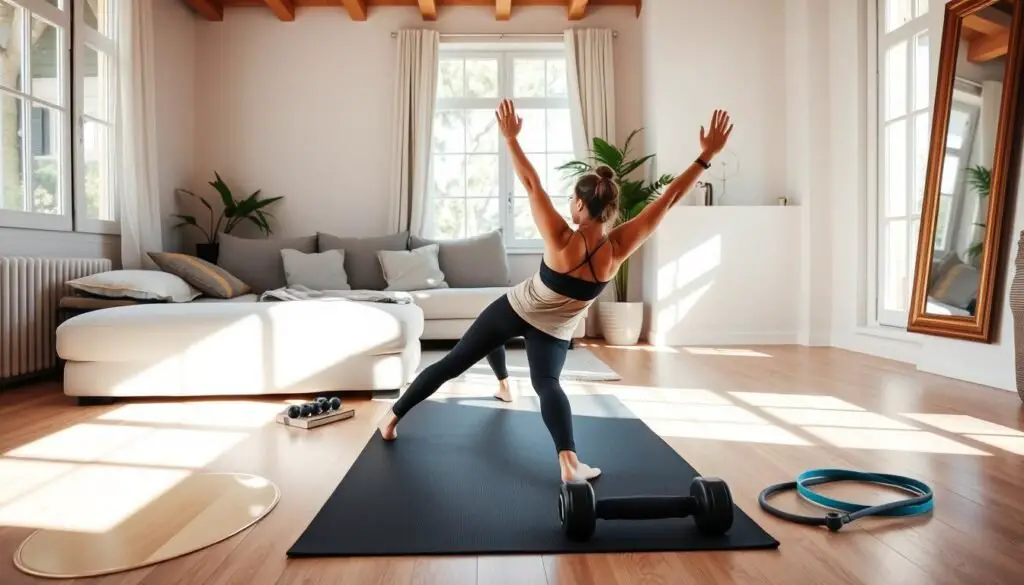
Cardiovascular Training Without Equipment
You don’t need fancy equipment for cardio workouts at home. In fact, some of the best fat-burning routines use just your body. Exercises like jumping jacks and burpees are great for a no equipment workout.
HIIT Workout Basics
High-Intensity Interval Training (HIIT) is a great way to do cardio workouts at home. It’s simple: switch between intense exercise and rest or low-intensity activity. For example, do 20-30 seconds of intense exercise, then 10-15 seconds of rest. Keep repeating this to get a good HIIT workout.
Cardio Exercise Selection
Choose exercises for your no equipment workouts that work different muscles and engage your whole body. Some top picks include:
- Jumping jacks
- High knees
- Burpees
- Mountain climbers
Do 30 seconds of each exercise, then rest for 30 seconds. Repeat this 3-4 times. As you get fitter, increase the exercise time and decrease rest.

“Cardiovascular exercise is essential for overall health and fitness, and you can achieve an effective cardio workout at home without any special equipment.”
Adding these simple yet effective fat-burning routines to your routine can boost your heart health, endurance, and metabolism. And you can do it all from home.
Progressive Overload in Home Training
To see real progress in your strength training at home, you need to keep challenging yourself. This means using the principle of progressive overload. It’s about slowly making your workouts harder over time. This way, you keep pushing your muscles to grow and get fitter.
One easy way to do this is by doing more reps. Start with 10 push-ups and try to do 15 or 20 later. When you can do more reps easily, try harder versions like regular push-ups.
Another good idea is to make your exercises more challenging. For squats, aim to go deeper. Try jump squats to add a new twist. Use exercises like incline or decline push-ups to adjust the difficulty level.
| Progression Technique | Examples |
|---|---|
| Increase Repetitions | Start with 10 push-ups, progress to 15, then 20 |
| Enhance Range of Motion | Deeper squat depth, jump squats |
| Adjust Exercise Difficulty | Incline/decline push-ups, assisted pull-ups |
Keeping track of your progress is key. It helps you know if you’re getting stronger and building muscle. By making your workouts harder, you’ll get stronger, build muscle, and keep your workouts interesting. All from the comfort of your home.
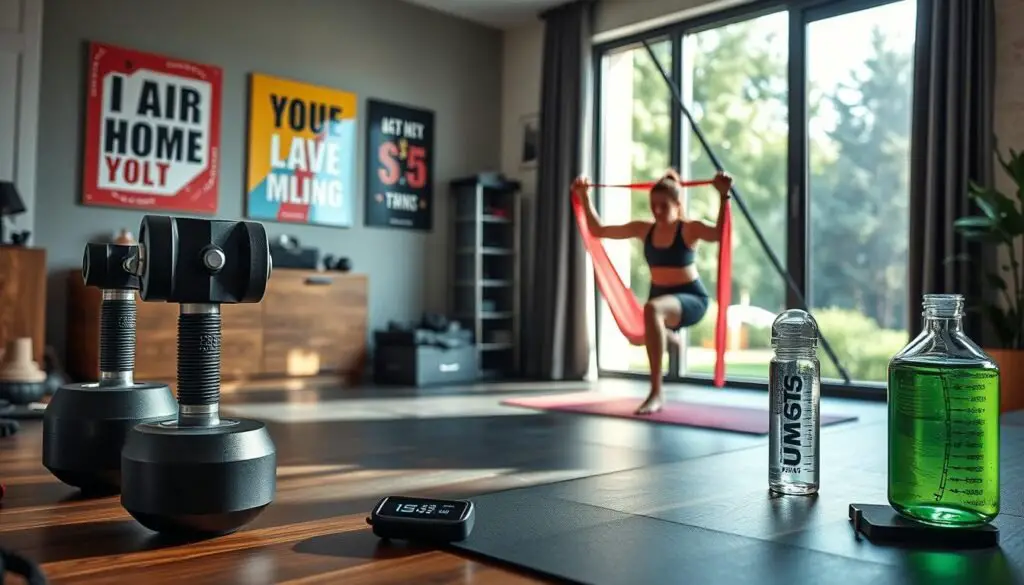
“Progressive overload is the key to continuous muscle growth and improved fitness in any workout program, including at-home training.”
Recovery and Rest Periods
Reaching your fitness goals as a beginner is more than just working out. It’s also about rest and recovery. Knowing the right rest times and recovery weeks helps your body heal and get stronger.
Optimal Rest Between Sets
For beginners, rest times between sets should be 30 to 90 seconds. The exact time depends on how hard the exercise is. For tough exercises like squats or push-ups, rest for 60-90 seconds. For easier ones, 30 seconds is enough.
Weekly Recovery Guidelines
- Rest for at least 48 hours between workouts for the same muscles.
- Use active recovery days with light activities like yoga or walking. This keeps your body moving while it rests.
- Try to sleep 7-9 hours each night to help your muscles recover and grow.
- If you’re too tired or sore, lower the intensity of your workouts.
By following these tips, you’ll give your body the rest it needs. This leads to better results and less chance of injury in your fitness journey.
| Activity | Recommended Frequency | Benefits |
|---|---|---|
| Strength Training | 2-3 times per week | Builds muscle, increases bone density, and improves overall strength. |
| Cardio | 150-300 minutes per week | Improves cardiovascular health, boosts endurance, and supports weight management. |
| Active Recovery | 1-2 times per week | Promotes circulation, reduces inflammation, and aids in muscle recovery. |
Listening to your body and adjusting your routine is key to a good beginner fitness program. With proper rest and recovery, you’ll reach your at-home training goals.
Creating a Sustainable Workout Schedule
Creating a consistent workout routine is crucial for beginners. The best home workout routine for beginners is one that fits your lifestyle. It should keep you motivated over time.
Try to do 3-4 workouts a week. Mix strength training with cardio exercises. Here’s a sample weekly schedule:
- Monday: Full-body strength training
- Wednesday: Cardio or HIIT workout
- Friday: Full-body strength training
- Saturday: Light cardio or yoga
Begin with 20-30 minute sessions. As you get stronger, increase the time. Set achievable goals and track your progress. Adjust your schedule as needed to fit your lifestyle and fitness level.
Finding a balance is key to a sustainable workout routine for beginners. A consistent schedule helps build a lifelong habit of staying active. This will help you achieve your best home workout routine for beginners.
Form and Technique Fundamentals
When starting strength training for beginners, it’s key to focus on form and technique. This ensures your workouts are effective and safe. Whether you’re doing bodyweight exercises or using equipment, knowing the basics of good form is vital.
The squat is a fundamental exercise to master. Keep your chest up and your knees in line with your toes. This helps you use the right muscles and avoid injury. For push-ups, keep your body straight and lower your chest all the way down.
- Keep your chest up and knees aligned with your toes during squats
- Maintain a straight body line and lower your chest to the ground during push-ups
- Ensure your front knee stays above your ankle and your back knee nearly touches the ground during lunges
Use mirrors or record yourself to check your form. This helps spot any mistakes and fix them. Focus on doing each exercise right, even if it means doing fewer reps. If your form gets bad, do fewer reps or try an easier version.
If you’re not sure about your form, look for online tutorials or virtual personal training. These can offer valuable feedback and help you improve your strength training for beginners skills.
“Proper form is essential for maximizing the effectiveness of your workouts and reducing the risk of injury.”
Nutrition Support for Home Training
Good nutrition is key for better workout performance and recovery. It’s important for muscle building or fat-burning routines. Your diet greatly affects your fitness journey.
Pre-workout Nutrition
It’s important to fuel up before working out at home. Eat easy-to-digest carbs and protein 1-2 hours before. Try a banana with peanut butter or Greek yogurt with berries.
Don’t forget to drink water before and during your workout. Staying hydrated is crucial.
Post-workout Recovery Meals
After your workout, eat a mix of protein and carbs within 30-60 minutes. A grilled chicken breast with brown rice or a protein shake with fruit is great. Eating whole foods helps with muscle recovery and growth.
If you need help with your diet, talk to a nutritionist. They can give you personalized advice.
FAQ
What are the benefits of home workouts for beginners?
Home workouts save time and money. They offer privacy and comfort. You can work out at your own pace without feeling judged.
They also fit into your schedule easily. This helps you stay consistent with your fitness routine.
What equipment is needed for effective home workouts?
You don’t need much equipment. Your body weight is enough for exercises like push-ups and squats. Dumbbells or resistance bands can be helpful.
A yoga mat makes exercises more comfortable. A chair is useful for squats and other exercises. Start with bodyweight exercises before adding equipment.
What are the proper warm-up techniques for home exercise?
A good warm-up gets your muscles ready and your heart rate up. Try jogging in place or arm swings. Do easier versions of your workout as a warm-up.
Exercises like jumping jacks or high knees are great. They help warm you up and get your blood flowing.
What is the best home workout routine for beginners?
Start with exercises like wall push-ups and squats. Do 2 sets of 10-15 reps for each. Rest for 30-60 seconds between moves.
This full-body workout takes 15-20 minutes. Focus on proper form and increase the difficulty as you get stronger.
What are the essential bodyweight exercises for beginners?
Beginners should do push-ups, squats, and planks. Keep your hands shoulder-width apart for push-ups. Stand with your feet shoulder-width for squats.
For planks, keep your body straight and engage your core. Proper form is key for these exercises.
What core-strengthening exercises can be done at home?
Planks, bicycle crunches, and Superman poses are great for your core. Hold planks for 30 seconds to 1 minute. Bicycle crunches work your obliques.
Bird dogs improve balance, and Superman poses strengthen your back. Do 2-3 sets of each, focusing on your core.
What are some effective cardio exercises for home workouts?
Jumping jacks, high knees, and burpees are good cardio exercises. Mix them up for a full-body workout. Start with 20-30 seconds of high-intensity exercise followed by 10-15 seconds of rest.
As you get fitter, increase the exercise time and decrease rest periods.
How can I progressively increase the difficulty of my home workouts?
Increase the difficulty by doing more reps or sets. Start with 10 knee push-ups and move to 15, then standard push-ups. For squats, try deeper squats or jump squats.
Track your progress and increase the challenge every 1-2 weeks. This will help you get stronger and more fit.
How important is recovery for home workouts?
Recovery is key for muscle growth and injury prevention. Rest for 30-90 seconds between sets. Give your muscles 48 hours to recover before working them again.
Use active recovery days with light activities. Get 7-9 hours of sleep each night. Listen to your body and adjust your workout if needed.
How can I create a sustainable workout schedule for home training?
Aim for 3-4 workouts a week, alternating between strength and cardio. Start with 20-30 minute sessions and increase as you get more comfortable.
Set realistic goals and track your progress. Adjust your schedule as needed to fit your lifestyle and fitness level.
Why is proper form important for home workouts?
Proper form makes your workouts effective and safe. For squats, keep your chest up and knees aligned. For push-ups, maintain a straight body line.
Use mirrors or record yourself to check your form. Focus on quality over quantity. If your form is off, reduce the reps or choose an easier version.
How important is nutrition for home workouts?
Good nutrition is vital for workout performance and recovery. Eat carbs and protein 1-2 hours before your workout. Stay hydrated during your workout.
After your workout, eat a mix of protein and carbs within 30-60 minutes. Focus on whole foods and plenty of fruits and vegetables. Get personalized nutrition advice if needed.

One Reply to “Best Home Workout Routine for Beginners”